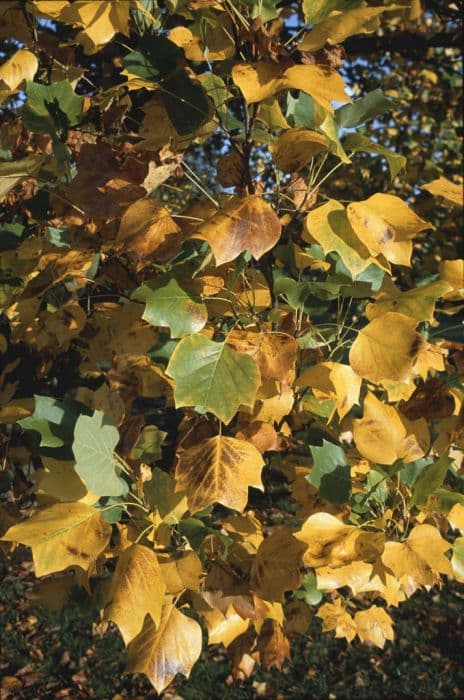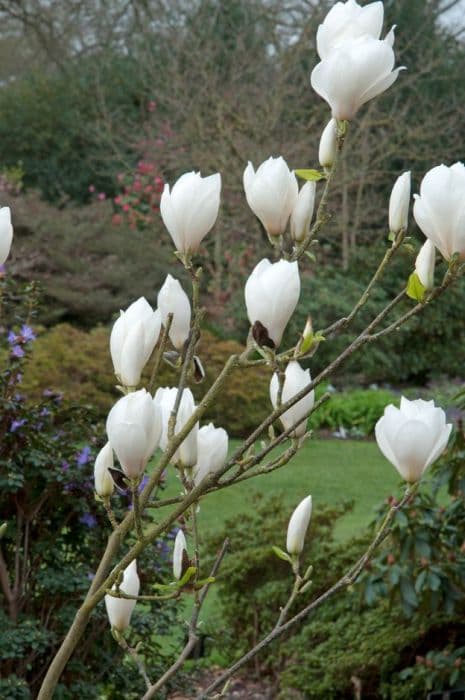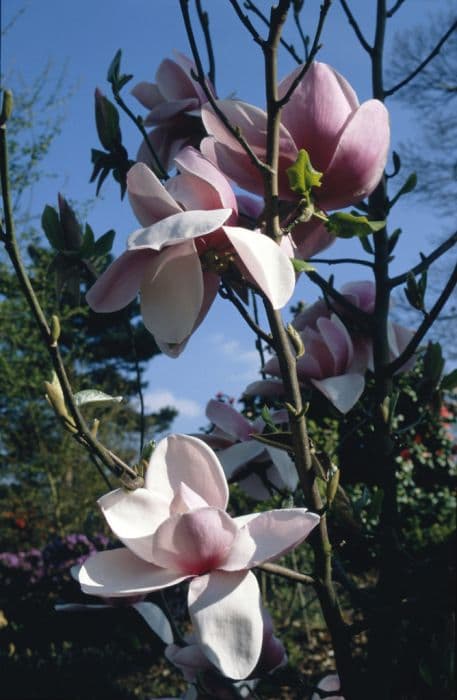Magnolia Magnolia 'Summer Solstice'

ABOUT
Magnolia 'Summer Solstice' is an ornamental plant known for its striking and large creamy white flowers. These blooms often have a waxy texture and may display a faint blush of pink near the base, giving them a two-toned effect. The flowers exude an enchanting fragrance and have a prominent central cone made up of spirally arranged reproductive structures, which include both stamens and pistils. The leaves of 'Summer Solstice' are glossy and dark green, providing a lush backdrop for the flowers. The foliage often emerges with a bronze tinge before maturing to its deep green hue. This plant exhibits a strong branching structure and a symmetrical canopy which adds to its garden appeal. The bark is smooth and gray, adding to the visual interest of the plant throughout the seasons.
About this plant
 Names
NamesFamily
Magnoliaceae
Synonyms
Summer Solstice Magnolia
Common names
Magnolia 'Summer Solstice'.
 Toxicity
ToxicityTo humans
Magnolias, including the 'Summer Solstice' cultivar, are generally not considered to be toxic to humans. They are not known for causing poisoning if ingested, so there is likely no cause for concern if small quantities are accidentally consumed.
To pets
Magnolias, such as the 'Summer Solstice' variety, are not typically toxic to pets either. They are not known to cause serious harm or poisoning if pets happen to ingest parts of the plant. However, it's always best to prevent pets from eating plants, as individual animals might have sensitivities or allergic reactions.
 Characteristics
CharacteristicsLife cycle
Perennials
Foliage type
Deciduous
Color of leaves
Green
Flower color
Creamy-white
Height
20-25 feet (6-7.6 meters)
Spread
10-15 feet (3-4.6 meters)
Plant type
Tree
Hardiness zones
5
Native area
Cultivar
Benefits
 General Benefits
General Benefits- Aesthetic Appeal: Magnolia 'Summer Solstice' provides large, fragrant creamy-white flowers, which are attractive and can enhance the beauty of any garden or landscape.
- Long Blooming Season: This magnolia variety is known for its long blooming season, offering visual interest throughout the warmer months.
- Drought Tolerance: Once established, Magnolia 'Summer Solstice' can tolerate dry conditions, reducing the need for frequent watering.
- Cold Hardy: It is capable of withstanding colder temperatures, making it suitable for a range of climates.
- Wildlife Attraction: The flowers attract pollinators such as bees and butterflies, supporting local ecosystems.
- Shade Provision: The dense foliage provides shade and cooling, which can be beneficial during hot summers.
- Versatility: Magnolia 'Summer Solstice' can be used as a specimen tree, in borders, or as part of a larger shrubbery, offering versatile landscaping options.
- Evergreen Qualities: In milder climates, the plant can retain its leaves year-round, providing constant greenery.
 Medical Properties
Medical PropertiesThis plant is not used for medical purposes.
 Air-purifying Qualities
Air-purifying QualitiesThis plant is not specifically known for air purifying qualities.
 Other Uses
Other Uses- Magnolia cone bird feeders: Dry the seed cones and coat them in peanut butter and birdseed to create a natural bird feeder.
- Natural fencing: Planting several Magnolia 'Summer Solstice' trees in a row can create a dense, green, living fence for privacy.
- Photography prop: The beautiful blooms can be used as a backdrop or a prop for outdoor spring and summer photo shoots.
- Pot-pourri: Dried petals add a lovely scent and a touch of elegance when mixed into pot-pourri.
- Wedding decorations: Fresh or dried magnolia leaves and blossoms can be used in floral arrangements or as venue decorations for a natural, romantic touch.
- Baking decoration: Edible magnolia flowers can be crystallized with sugar and used to decorate cakes and desserts.
- Leaf crafts: The large, sturdy leaves can be painted and used for various craft projects, such as making prints or bookmarks.
- Fabric dye: The bark and flowers can be boiled down to create natural dyes for fabrics, although they may not be as potent as commercial dyes.
- Ink making: Similar to dye, the plant's components can be used to create natural, plant-based inks for art and calligraphy.
- Culinary garnish: Though not commonly known for its use in cooking, magnolia petals can be used as an elegant garnish for special dishes, after ensuring they're safe and pesticide-free.
Interesting Facts
 Feng Shui
Feng ShuiThe Magnolia is not used in Feng Shui practice.
 Zodiac Sign Compitability
Zodiac Sign CompitabilityThe Magnolia is not used in astrology practice.
 Plant Symbolism
Plant Symbolism- Perseverance - Magnolias are known to be resilient and can withstand harsh conditions, symbolizing one's ability to endure difficulties.
- Nobility - Often associated with the aristocracy, especially in the South of the United States, the magnolia represents dignity and pride.
- Femininity - With their distinct shape and delicate petals, magnolias symbolize grace, beauty, and gentleness, qualities traditionally ascribed to femininity.
- Purity - The bright white blossoms of some magnolias signify purity and innocence.
- Hospitality - Due to the welcoming nature of its large, fragrant flowers, magnolias are often associated with friendliness and warmth.
 Water
WaterThe Southern Magnolia should be watered deeply, enough to saturate the root zone, which typically means applying about 1.5 gallons for younger trees and as much as 5 gallons for more mature trees. When newly planted, water twice a week to establish roots, then adjust to once a week during active growth in spring and summer. During the fall and cooler months, reduce watering frequency to every two to three weeks, depending on the weather. Always check the soil moisture before watering; the soil should be moist but not waterlogged.
 Light
LightSouthern Magnolias thrive in full sun to partial shade. They perform best when they receive at least 4-6 hours of direct sunlight daily. The ideal spot for these magnolias would be an area where they get morning sunlight and are protected from the intense heat of the late afternoon sun.
 Temperature
TemperatureSouthern Magnolias are hardy and can tolerate temperatures from about 0°F to over 100°F. The ideal temperature range for optimal growth is between 70°F and 90°F. They can survive occasional dips below freezing, but prolonged exposure to temperatures below 0°F may damage the plant.
 Pruning
PruningPrune Southern Magnolias to remove dead or damaged branches, to shape the tree, or to control its size. The best time to prune is in late winter or early spring before the new growth starts. Annual pruning is usually sufficient unless there are broken or diseased branches that need to be removed immediately.
 Cleaning
CleaningAs needed
 Soil
SoilMagnolias 'Summer Solstice' thrive in well-draining, rich, loamy soil with a slightly acidic to neutral pH of 5.5 to 7.0. A mix of two parts loam, one part peat moss, and one part compost provides the necessary nutrients, drainage, and aeration.
 Repotting
RepottingMagnolia 'Summer Solstice' typically does not require frequent repotting and should only be repotted every 2 to 4 years to refresh the soil and accommodate root growth. Young trees may benefit from annual repotting.
 Humidity & Misting
Humidity & MistingMagnolia 'Summer Solstice' prefers moderate humidity levels, but as an adaptable outdoor plant, it tolerates a wide range of humidity conditions typical of temperate climates.
 Suitable locations
Suitable locationsIndoor
Provide bright, indirect light and room to grow.
Outdoor
Plant in well-drained soil, full sun to partial shade.
Hardiness zone
5-9 USDA
 Life cycle
Life cycleThe life of a Magnolia 'Summer Solstice', also known as Summer Solstice Magnolia, begins with seed germination, which occurs in ideal moist, well-drained soil conditions with adequate warmth. The seedling stage is marked by the emergence of the first set of true leaves, after which the plant enters a period of vegetative growth where it develops a sturdy stem and mature leaves. During the flowering stage, the Summer Solstice Magnolia produces large, fragrant blooms typically in late spring to early summer, showcasing creamy white flowers with pinkish-purple bases. After pollination, usually by beetles attracted to the scent and color of the flowers, the plant develops fruit in the form of aggregate cones containing red seeds. The seeds may fall to the ground and, given the right conditions, can germinate to repeat the cycle, while the parent plant enters a period of dormancy in the winter months. Throughout its life, the Summer Solstice Magnolia will undergo annual cycles of growth, flowering, and dormancy, living for many years if conditions are favorable.
 Propogation
PropogationPropogation time
Spring-Early Summer
The Magnolia 'Summer Solstice', often referred to by its common name Summer Solstice Magnolia, is primarily propagated through the method of softwood cuttings. This process typically occurs during the late spring to early summer when the plant's new growth is still tender and green. To propagate, a gardener should choose a healthy branch that has just started to harden, known as softwood. From this branch, a cutting about 4 to 6 inches long is taken, ideally with a few leaves present. The bottom leaves are removed, and the cut end is often dipped in a rooting hormone to encourage root development. This cutting is then placed in a well-draining potting mix, ensuring that at least one leaf node, the spot where leaves emerge, is below the soil line to foster roots. The soil should be kept moist but not waterlogged, and the cutting should be placed in a warm location with indirect sunlight until roots have developed, which can take several weeks.









